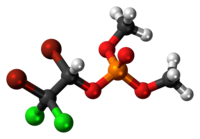Naled
 |
|
 |
|
| Names | |
|---|---|
|
IUPAC name
Dimethyl-1,2-dibromo-2,2-dichlorethyl phosphate
|
|
| Other names
Dibrom, 1,2-Dibromo-2,2-dichloroethyl dimethyl phosphate
|
|
| Identifiers | |
| 300-76-5 | |
| 3D model (Jmol) | Interactive image |
| ChEBI | CHEBI:38729 |
| ChemSpider | 4267 |
| ECHA InfoCard | 100.005.545 |
|
|
|
|
| Properties | |
| (CH3O)2P(O)OCHBrCBrCl2 | |
| Molar mass | 380.8 g/mol |
| Appearance | Colorless to white solid or straw-colored liquid |
| Density | 1.96 mg/mL (25°C) |
| Melting point | 27 °C; 80 °F; 300 K |
| Boiling point | decomposes |
| Vapor pressure | 0.0002 mmHg (20°C) |
| Hazards | |
| Safety data sheet | MSDS |
| Flash point | noncombustible |
| Lethal dose or concentration (LD, LC): | |
|
LD50 (median dose)
|
156 mg/kg (inhaled, mouse) 222 mg/kg (oral, mouse) 160 mg/kg (oral, rat) 430 mg/kg (oral, mammal) 250 mg/kg (oral, rat) 330 mg/kg (oral, mouse) |
| US health exposure limits (NIOSH): | |
|
PEL (Permissible)
|
TWA 3 mg/m3 [skin] |
|
REL (Recommended)
|
TWA 3 mg/m3 [skin] |
|
IDLH (Immediate danger)
|
200 mg/m3 |
|
Except where otherwise noted, data are given for materials in their standard state (at 25 °C [77 °F], 100 kPa).
|
|
| Infobox references | |
Naled (Dibrom) is an organophosphate insecticide. Its chemical name is dimethyl 1,2-dibromo-2,2-dichloroethylphosphate.
Naled is stable in anhydrous condition and must be stored away from light. It must also be stored under normal pressure and temperatures. It degrades in the presence of water and alkali, and produces toxic chloride fumes if exposed to acids or acidic fumes. Contact with metals, reducing agents, or sulfhydryls cause naled to release bromide and revert to dichlorvos.
Naled is used primarily to control adult mosquitos. It is also registered to control black flies, and leaf eating insects on a variety of fruits, vegetables, and nuts. Approximately 70% of naled in USA is used in mosquito control, and approximately 30% in agriculture. Naled has also been used in veterinary medicine to kill parasitic worms in dogs.
It has been used extensively within the United States since the 1950s. Naled was used in New Orleans after Hurricane Katrina and has been used historically in Puerto Rico to control dengue.
The Environmental Protection Agency has determined that exposure levels from eating crops treated with Naled are below the level of concern. With higher exposures, however, naled can cause cholinesterase inhibition in humans, which in turn can overstimulate the nervous system causing nausea, dizziness, confusion, and at very high exposures, respiratory paralysis and death. It has the UN hazard classification of 6.1 (inhalation hazard) and is prohibited for use as an insecticide within the EU.
Naled may cross the placenta if it is in the bloodstream of a mammal. Repeated exposures may also cause future behavioral problems, as well as issues with neurodevelopment, growth, and respiratory health in offspring. Chronic exposure to dichlorvos, a metabolite of naled, has also been linked to neurological issues, such as Parkinson's disease and nigrostriatal dopaminergic degeneration. Persons who work closely with naled or other organophosphate pesticides should undergo regular testing of their cholinesterase levels.
...
Wikipedia
